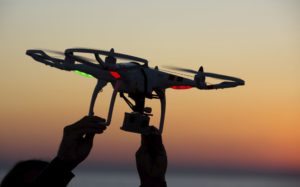We are Living the Future
That’s what I think to myself every time I see a new tech make its way into the Restoration industry.
All along the way, Moore’s Law has ensured that we never have to wait long for technology to become amazingly more useful and incredibly more affordable. It took about twenty years for digital cameras to become mainstream commodities. It’s been about ten years since restoration folks started using infrared. Now we’re witnessing the next evolution in Restoration documentation technology: Drones.
I remember seeing some of the first drones about five years ago. I was immediately enamored. Remote controlled camera platforms that have the versatility and acrobatic abilities of helicopters! What’s not to love?
These things were self-stabilized, rechargeable dream launchers. I wanted one. Until I found out the price of the drone mounted with a specialized IR camera…$10,000, ouch!!!. No drones were going to make their way into my Christmas stocking any time soon.
Today, owning my own drone is more than a possibility, it’s likely going to happen soon. The drones available on the market today are safer and more responsive than ever before. Just do a search on Amazon and you’ll find a complete drone camera kit for less than the cost of a high-end DSLR camera in 2010.
The things they can do is mind blowing. And now that the FAA has finally clarified their use, people from every industry are finding new uses for them.
Drones have officially crossed over from hobby toys to industrial tools, and here are a few of the reasons you should own one.
Unbeatable documentation speed and precision
When an insurance carrier starts acting like an early-adopter, we should all wake up and pay attention. In March 2015, State Farm became the first insurance company to gain approval from the FAA to test commercial applications of drones. The following month, three other insurers (USAA, AIG & Erie) joined the ranks of drone flyers.
Why? Because the speed and precision of gaining current aerial photography of a loss is incredible. The right photo can save an insurance company thousands of dollars. It can also make you thousands.
It takes a couple hours to properly inspect and photograph an average sized roof using a ladder and digital camera. Even longer with second stories and multiple pitches. Drones take this inspection time from hours to minutes.
Safety
I don’t know about any of you, but I’m deathly afraid of heights. Yes, I’m a 41-year-old 6′ 7″ man and I get nervous climbing a six-foot ladder to put up the Christmas lights (or Halloween lights because that’s how we roll). Over 80% of fall injuries are caused by ladders, and Restoration folks are on them all the time.
What if you didn’t have to climb an extension ladder ever again? That thought alone has me shopping for drones right now. And what about walking roofs in icy and wet conditions? Forget about it, literally.
Access Everywhere
You all know that sometimes there are spots that you just plain can’t reach with a human. Steep slopes prevent use of ladders; mean neighbors don’t allow access to adjacent yards or decks. There are many times that the only way to access an area to inspect is through the air.
Have you ever been unable to inspect a property because the structure had been deemed unsound? Now we can send in the drone.
Bird’s Eye View
Sometimes it helps to get a complete overview of a property to paint a thorough picture of a loss. Before drones, we relied on things like Google Earth maps and other satellite based inspection tools. The biggest problem with them is the pictures are months or even years old. I remember looking at my address once and seeing an empty lot, because I lived in a townhome that was less than two years old.
This data lag is problematic when trying to adjust for remodels/additions or landscaping changes. Did that tree come from the neighbor’s side? Some things are tough to tell unless you achieve the right perspective.
I believe we’re just beginning to see the useful applications of drones and autonomous technologies. I can easily envision a time in the near future when we pull up to a loss, pull our drone out of its case then set it loose to complete a full property survey on its own with a simple command click on our phone.
Written by Andy Mcabe at Claims Delegates LLC

Leave a Reply